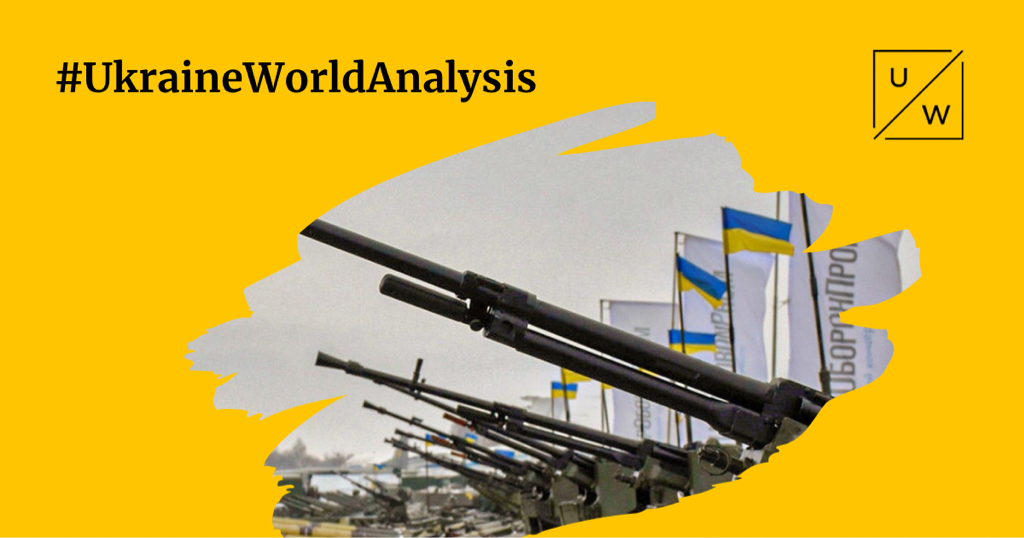UkraineWorld spoke to Nataliya Sad, spokeswoman for Ukroboronprom State Concern.
Key points - in our brief, #UkraineWorldAnalysis:
1. On the Ukrainian military-industrial complex
- To date, the Western weapons received by Ukraine after the full-scale invasion is less than 50% of the country's arsenal. This indicates that Ukraine's defenders are still fighting mostly with Soviet weapons which were inherited from the time of Ukrainian independence. It is a matter of keeping this entire arsenal in combat-ready condition. Many have the impression that creating a new combat unit is more difficult than repairing a damaged one. In fact, everything is the other way around.
- Production had to be moved due to the high probability of missile strikes and had to be carried out of the country. All this slows down the production process. Despite this, over 9 months this year, we have produced seven times more than we did in all of last year, and for some types of military equipment 10-12 times more. We are keeping up the pace because it is clear that enough equipment can turn the tide of the war.
2. On the best examples of Ukrainian weapons
- There is no such thing as too many weapons. The more arms, be they - Western, domestic, including modernized Soviet, or captured from the enemy - the greater the chances of a quick victory for Ukraine. The appearance of a single long-awaited unmanned aerial vehicle will not change the course of the war. For this, there would need to be a lot of them, and the production would need to be serialized. For example, when Ukraine faced mass attacks by Russian Orlan drones, it changed the rules of ground movement, camouflage, etc. for our troops.
- The Stugna, a Ukrainian man-portable anti-tank guided missile, was popular with our partners and included in export contracts before the full-scale invasion. During the full-scale invasion, the Stugna in particular turned into an anti-aircraft weapon, destroying Russian rotorcraft, including reconnaissance-strike Ka-52 "Alligator" helicopters. Today, Ukroboronprom has suspended all export contracts and is working exclusively to support the Ukrainian Armed Forces.
- Neptune, the anti-ship missile system which targeted the cruiser Moskva, speaks very loudly, as does the Vilkha MLRS. By the way, the appearance of Neptune in the theater of combat helped to set several records at once. Thus, Russia's large warship fleet was reduced by 16% in one strike. For the first time in 110 years, Russia lost the flagship of one of its fleets. Moskva became the first cruiser sunk in action in the world in 40 years. The world will give an assessment of the Ukrainian military industry after the end of this liberation war, when it starts ordering our military equipment.
- Today, we are witnessing an artillery war. In the future, we expect unmanned systems to be used in combat. When it comes to artillery, the Ukrainian army fights with Soviet 152 mm and 122 mm weapons. In order to be combat-ready, it is necessary to supply shells. The countries of the Warsaw Pact switched to the NATO standard of 155 mm caliber, which is not suitable for most of the artillery Ukraine uses. That is why we are now producing Soviet-type projectiles.
3. On rearmament of the Ukrainian Armed Forces
- This war will rearm the Ukrainian army. We have already launched production for components for Western artillery systems. We are concluding international agreements with our partners which provide not only for joint production, maintenance and repair of existing weapons, but also for joint construction.
- Currently, the reform of the Ukroboronprom concern is underway, which provides for flexible mechanisms of cooperation localizing production of Western weapons inside of Ukraine.
As a future member of NATO, Ukraine will receive military equipment that will help avoid similar wars in the future. Unfortunately, we will not be able to change our neighboring country, but our military-industrial complex must become a safeguard against these wars, so that our children and grandchildren no longer have to fight for the independence and freedom of our country.
DARIA SYNHAIEVSKA, ANALYST AND JOURNALIST AT UKRAINEWORLD
NATALIYA SAD, SPOKESWOMAN FOR UKROBORONPROM STATE CONCERN
This material was prepared with financial support from the International Renaissance Foundation.

